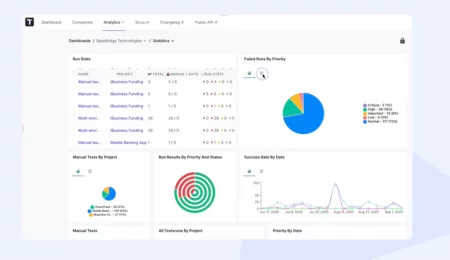The test automation space is turning into a huge coding AI partnership for development and testing teams and AI. Claude Code, which is combined with Playwright Model Context Protocol (MCP), transforms the way developers and QAs approach browser automation and testing. With the MCP Playwright server, they access browser automation features directly from Claude Code, which enables smooth communication between AI reasoning and browser testing in real-time.
In the article below, you can discover what Claude is, what challenges it can solve better than other AI agents, reveal different Playwright MCP workflows for Claude, and learn how to integrate Playwright with Claude AI through the Model Context Protocol (MCP).
What is Playwright Model Context Protocol for AI Testing?
Playwright MCP for AI Testing is a system that uses the Playwright browser automation tool with the Model Context Protocol (MCP). Thanks to this combination, AI agents and Large Language Models (LLMs) can effectively utilize the capabilities of the Playwright tool to engage with web pages via structured accessibility snapshots, run web testing and conduct automation tasks.
What is Claude?
Developed by American artificial intelligence company Anthropic, Claude is a new-generation large language model (LLM), which aims to understand, generate, and analyze big data sets, as well as solve complex problems and assist with programming, testing, research, and so on. This LLM is used in a wide variety of sectors and use cases. They are:
→ Web and mobile application development
→ Content creation and editing
→ Research and data analysis
→ Customer service and chatbots
→ Testing and code generation/refactoring
What is Claude Code and Playwright MCP Integration?
With Claude Code MCP integration, AI can assist your dev and testing team with Playwright automation. The MCP Playwright server provides developers with browser automation capabilities that they can access directly from Claude Code to create smooth interactions between AI reasoning and executing JavaScript in a real browser environment. This is a detailed explanation of how Claude Code Playwright MCP integration works:
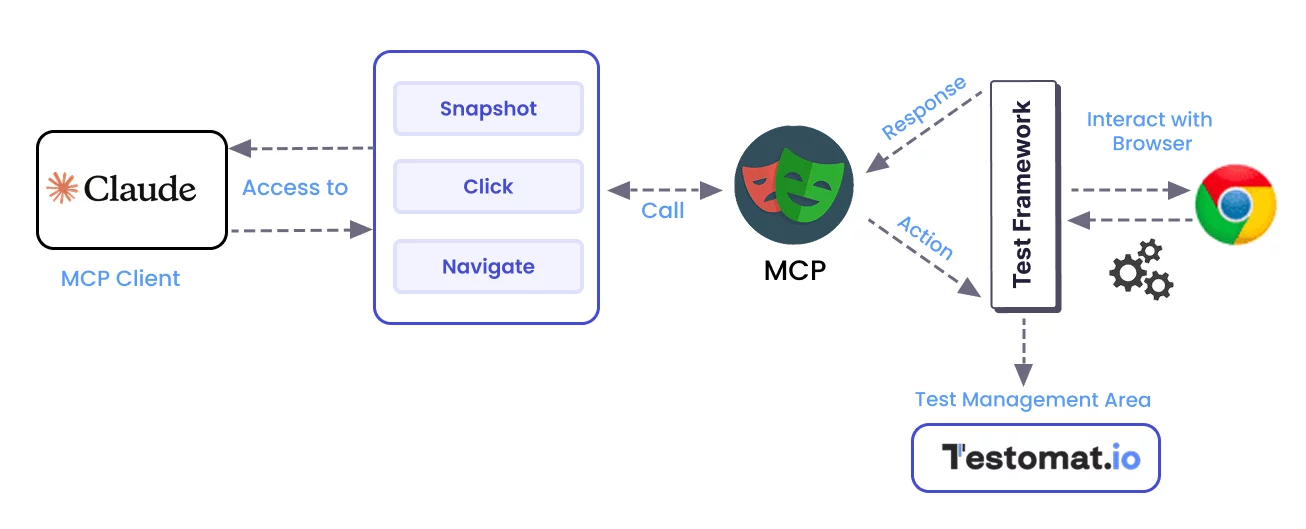
These are the components of the Playwright MCP server Claude code integration:
- Claude Code: Claude Code generates intelligent code and solves problems.
- MCP (Model Context Protocol): MCP (Model Context Protocol) allows Claude to communicate with external tools through its interface.
- Playwright MCP server: It provides users with access to browser automation features.
- Real-time validation: It performs real-time validation through Claude’s browser testing of its proposed solutions.
Playwright MCP Workflow for Claude: Key Stages
Here are the main stages in a basic Claude Code MCP Server Playwright Workflow:
- Setup the Model Context Protocol Server. At this step, you need to set up the Playwright MCP server package and configure it in your Claude Desktop settings file (claude_desktop_config.json), so that Claude (LLM) can directly control Playwright, launch browsers (Chromium, Firefox, WebKit), run tests, and see results without you having to manually copy-paste or execute code.
- Receive Requirements. Without knowing what feature/user story you are willing to test, LLM can’t do it. So you need to explain requirements, add key details (page URL, element selectors (IDs, classes), and mention what should happen on success/failure) so that LLM understands exactly what to automate.
- Plan Strategy. Here, written in plain English, requirements are broken down into a structured test plan, which allows you to cover all possible variants of test scenarios (happy path, error cases, edge cases) and the steps needed for each. It determines the sequence of actions, which elements to interact with, what assertions to make, and how to handle waits and validations for reliable test execution.
- Generate Code. LLM generates fully formed Playwright test scripts at this point, which follow proper structural guidelines. The test plan determines how the system will perform navigation operations and execute element interactions and assertions, and handle errors.
- Execute via MCP. The MCP connection enables LLM to run its automatically generated tests in real-time execution. AI uses this integration to start browsers automatically while taking screenshots and execution traces, and recording results without requiring human involvement.
- Analyze Results. The test output, error logs, and screenshots enable LLM to determine which tests passed and which failed, so it can find the source of the defects.
- Iterate and Enhance. The test code receives modifications from LLM to achieve stability through failure report analysis. AI makes automatic adjustments to selectors and waits and handles new edge cases until it reaches consistent pass results.
How to Set Up Playwright MCP for Claude Code
Cloud Claude code integration with any context or tool through connectors with a remote MCP is a paid service. Meet prices here; therefore, we recommend the Desktop version. The Playwright MCP Claude code Desktop integration requires specific steps to follow. Here’s how to do it:
- Install Application
- Open Claude Menu → Settings → Developer
- Edit config. You need to access the Claude Desktop configuration File, which is named
claude_desktop_config.jsonThen add or update the settings to define the MCP server with this JSON configuration snippet:
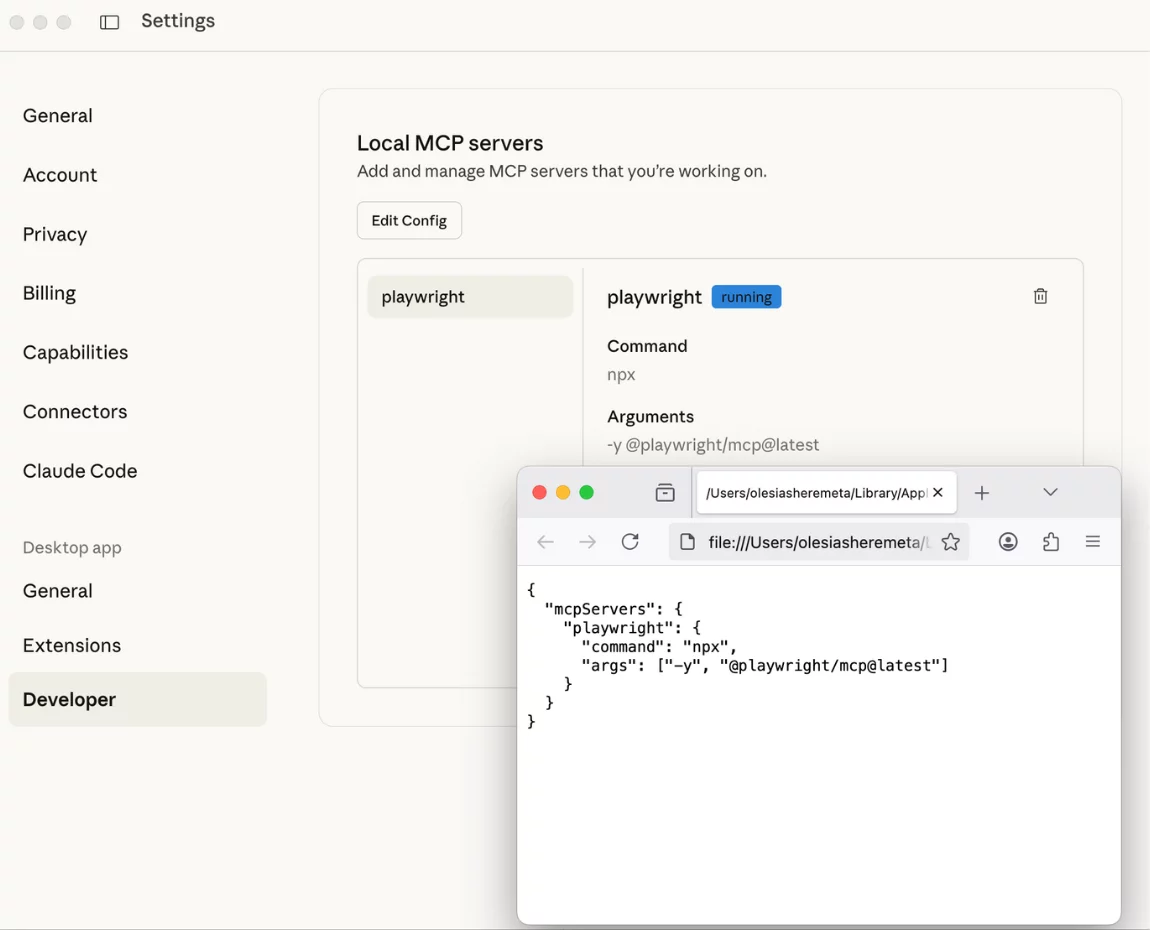
🔴 Remember that you need to save the file and restart Claude Desktop, so that a build logo, which contains all Playwright actions or methods, appears. After restarting, the Playwright tools are available for Claude to use in any conversation.
Microsoft Playwright MCP protocol and Claude Workflows
So, now we can start! The workflow may begin with defining requirements based on insights from team test review sessions — commonly known as 3 Amigos sessions. LLM can formulate requirements, produce requirements-based tests, and QA engineers only follow them with static test analysis and make code optimization. Look at the Three Amigos Claude Workflow visualization below 👀
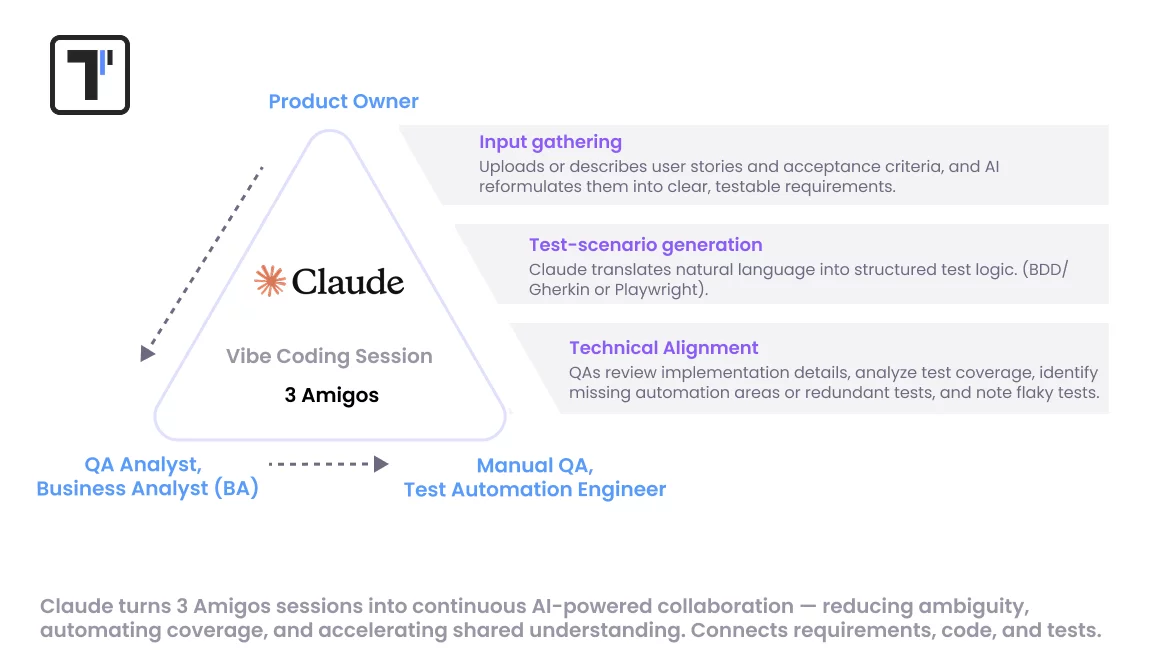
Then, Playwright MCP runs them automatically, showing real-time results and AI suggest fixing errors independently. Below, you can learn more:
#1: Generate Requirements
You can describe your requirements, and based on this information, Claude can identify the most relevant test scenarios and create an effective test strategy to verify your application thoroughly.
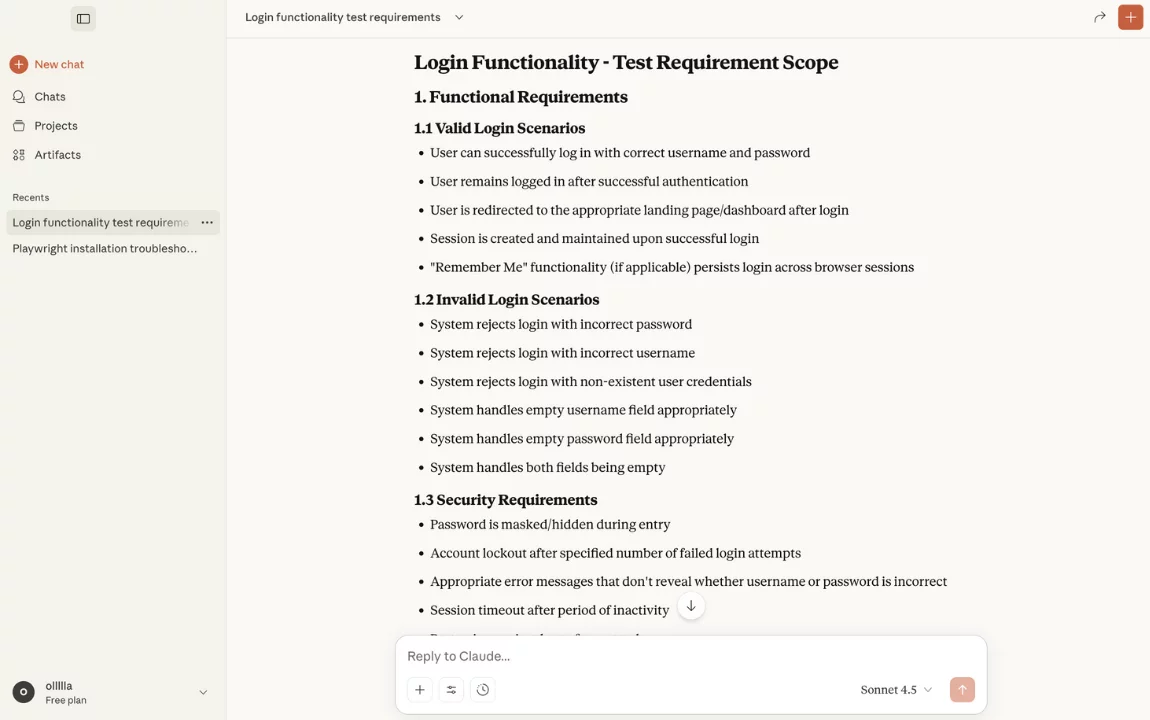
If you are tired of writing automated tests from scratch, covering multiple scenarios (success, failures, validations), you can freely use Claude to create Playwright tests.
#2: Running First Claude Playwright Test to check connection
Now you can use your spoken commands, which Claude executes directly. The system uses your step-by-step test descriptions to generate functional tests automatically
👀 Here is an example of instructions for LLM:
Navigate to https://testomat.io
Find and click on the "Blog" link in the navigation menu
Once on the Blog page, take a screenshot named "testomat-blog"
Get the content of the Blog pageClaude, via MCP integration, executes these instructions without manual scripting.
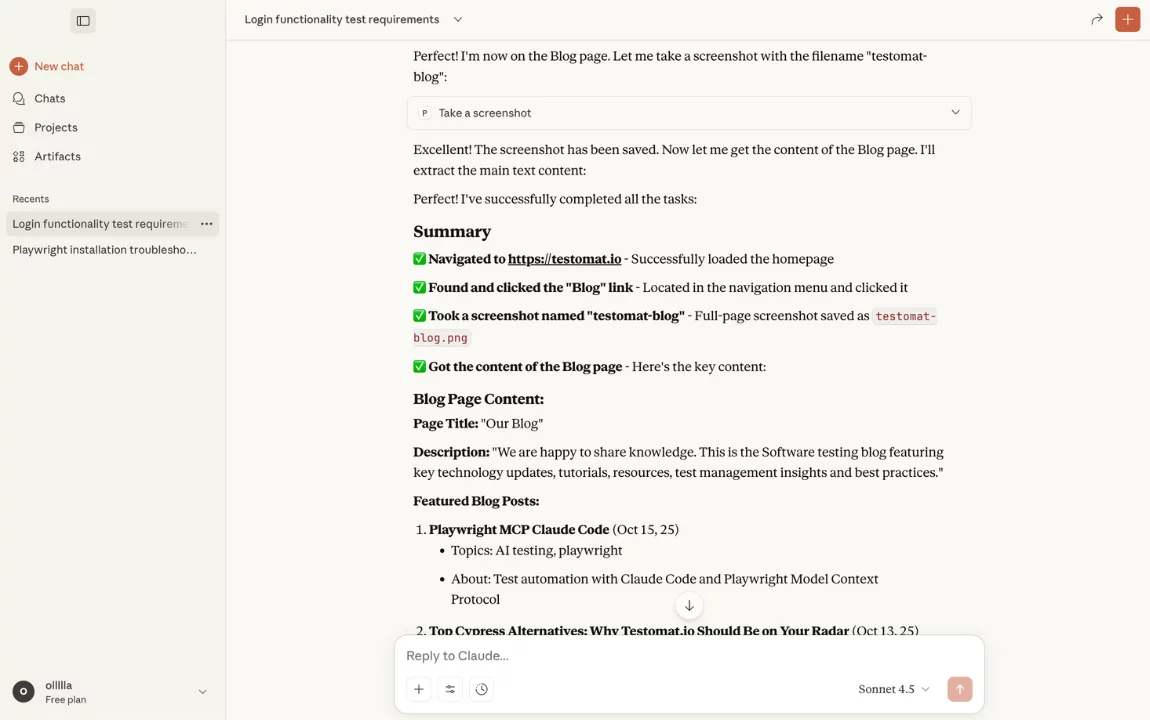
You can find the screenshot in the temporary storage directory /tmp. You may copy it to a permanent location if you need to keep it long-term.
#3: Prompting Claude To Verify Playwright Login Tests
Determine an assertion strategy to create Playwright tests. Here is an example of the prompt:
Generate Test validation for invalid password
Verify Error message
Details:
URL: https://app.testomat.io/users/sign_in
Username field: [data-testid="username"]
Password field: [data-testid="password"]
Submit button: [data-testid="login-button"]
Error message: [data-testid="error- message"]As a result, we got a code of test. Claude described how to install Playwright, a basic test framework project structure and how to execute it:
npm install -D @playwright/test
npx playwright install
```
### Project Structure
```
your-project/
├── tests/
│ └── invalid-password.spec.ts
├── playwright.config.ts
└── package.json
npx playwright test invalid-password.spec.tsLet’s ask to execute this test scenario with Claude 👀
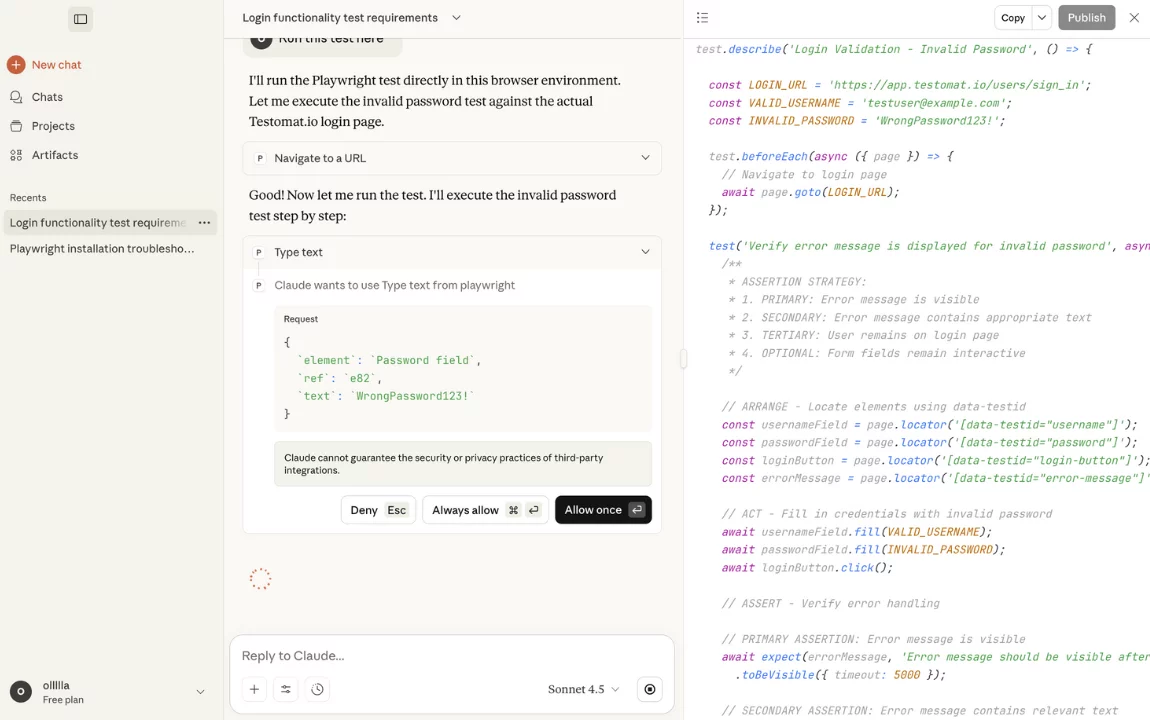
#4: Analyze Results
In fact, executing this scenario with Claude AI takes quite a long time — around 7 minutes in my case. Don’t mind the seconds shown in the report. This test execution is definitely time-consuming.
However, the Claude interface also provides users with an opportunity to receive immediate feedback and understand their mistakes. End-to-end AI analysis makes debugging and error detection easier and gain AI-driven insights for improving your testing strategy.
#5: Optimization: Claude Suggesting Better Selectors Or Refactoring Test Steps
The test quality improves through Optimization with Claude because it converts rigid functional code into a dependable asset that remains easy to maintain. The system continues its operation after passing a test by conducting automatic code optimization assessments. Claude detects unstable or flaky tests and proposes more robust Playwright locators and selectors to improve test reliability, in particular the test automation strategy.
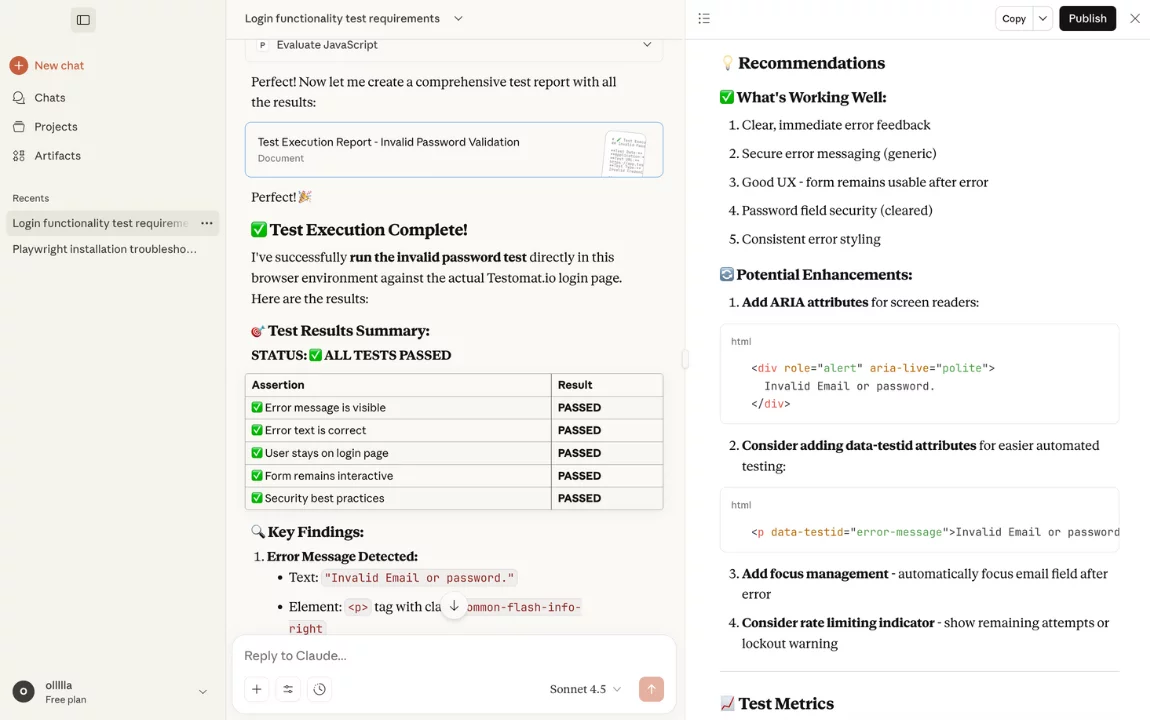
AI evaluates test procedures to detect both prolonged operations and duplicated actions. Claude applies its optimization capabilities to convert repeated code segments, including login procedures and sequential assertions, into reusable Page Object components and helper functions. By analyzing coverage gaps, Claude suggests additional test cases to strengthen your Playwright test suite.
#6: Failure Analysis. Asking Claude To Explain A Failed Test Log
The combination of Claude with MCP enables failure analysis to convert manual debugging into an intelligent step-by-step process. You can share error logs and stack traces, and optional screenshots with Claude after a Playwright test failure, so it can perform multiple failure assessments to detect selector problems and timing issues and assertion discrepancies, and state management problems. Let’s try to correct the error with Claude ⤵️
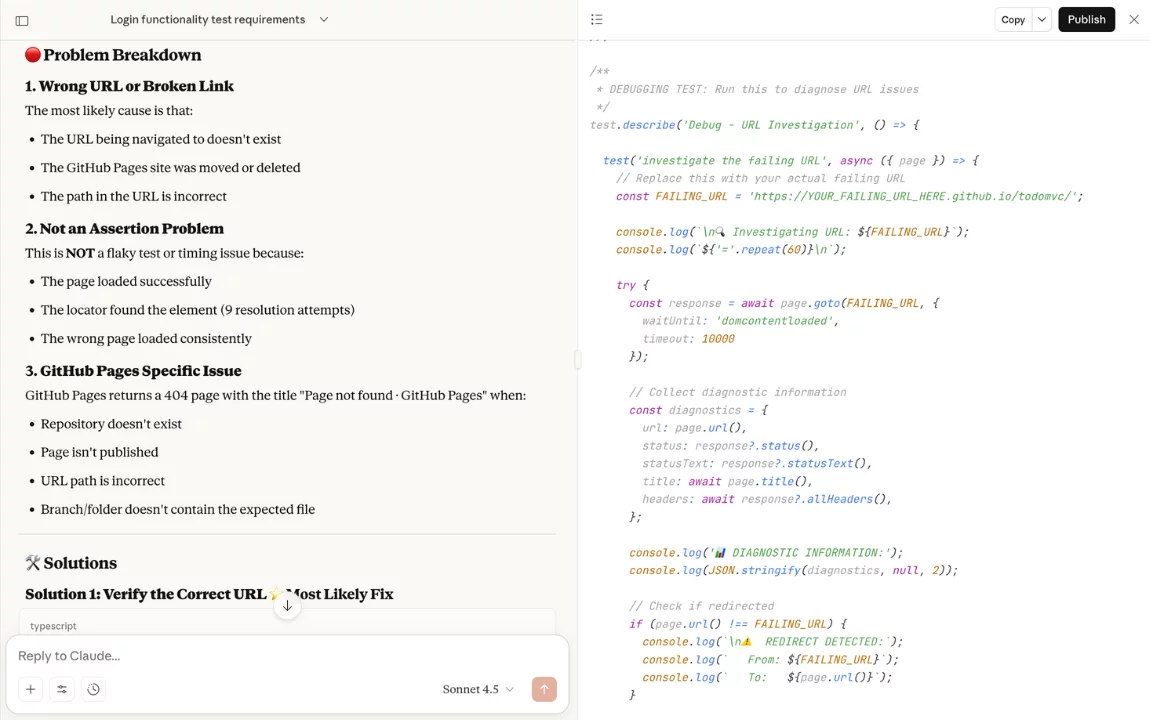
LLM identifies the main problem through its ability to understand both your test code and the actual execution results before offering precise steps with corrected code examples. This LLM tool can debug error outputs faster sometimes than traditional trial-and-error methods, but as you can see, we should limit the length of the answer with a prompt.
#7: Collaboration: Using Claude For Test Review In Three Amigos Sessions
The known Three Amigos session provides immediate feedback to the review process. The team, consisting of a Product Owner, Developer, and Tester, can use Claude to produce and evaluate test scenarios in real-time during user story definition and refinement. The team can concentrate on defining the purpose and requirements while Claude examines the implementation structure to detect incomplete edge cases and unclear requirements, and logical errors before any production code development begins. This collaborative approach produces an efficient shared understanding, which creates precise acceptance criteria and produces reliable tests that minimize future development cycle rework and misunderstandings.
Also, Claude provides natural-language summaries of Playwright test results, highlighting trends, failures, and improvement areas for QA reports understandable to all stakeholders, even non-techies.
How does Claude enhance Playwright automation?
- Claude uses requirements (user stories or descriptions) for autonomous test generation, which allows teams to make the initial test creation phase faster as well as runnable scripts.
- When a test fails, Claude analyzes the full report so that the root cause of the failure (timing issue, bad selector, or app bug) can be determined, and then LLM suggests some variants for debugging.
- The failure analysis enables Claude LLM to automatically modify and fix the code in tests. Thanks to the ability to run tests through Playwright again and again until they are fixed and the logic is improved, and edge cases are addressed, LLM achieves high results in the testing process.
- Claude is also useful when you need to improve the quality and maintainability of the passing code, refactor repetitive steps into reusable functions, suggest more robust locators, and optimize wait strategies, so that you can get a reliable automation framework.
Why is Claude better than Copilot?
- It enables you to create a testing approach through detailed planning that optimizes the combination of E2E tests, integration tests, and unit tests for achieving both fast execution and complete coverage.
- It lets you run a dependable test suite because it delivers complete debugging assistance at an expert level for identifying individual test failures, performing extensive refactoring, and removing test instability.
- It enables you to develop the optimal solution by engaging in collaborative dialogue, which uses its advanced knowledge to QA concepts until it reaches a perfect final goal.
- It enables you to maintain clean and scalable test code through the development of strong Page Object Models (POMs), which simplify maintenance tasks.
- It helps you avoid project setup and deployment hassles because it handles the entire project initialization process, including TypeScript, config files, and creates efficient CI\CD pipelines for running tests across multiple browsers and environments in parallel.
- It teaches Playwright concepts through problem-solving while providing complete inline documentation and explaining its reasoning so that users can develop expertise and cultivate skills.
When does MCP Claude not work?
- When you are dealing with real-time applications and your system needs to respond within 100ms.
- When the high data volume from processing millions of records and continuous automated monitoring leads to excessive per-token costs that make the solution economically unfeasible.
- When workflow requires deep integration with the IDE for inline code refactoring functionality.
- When you require low-level binary operations and handling of files that surpass the context window restrictions of the model.
- When there is no internet access for remote locations or when connections are unreliable to function correctly.
- When your organization has established IP/NDA policies that enforce such limitations, the process of sending confidential code to an external cloud API becomes restricted.
Challenges, Best Practices, and Problem-Solving Abilities of the Claude
Below, we are going to discuss common challenges that can be tackled thanks to using Claude’s abilities during the process:
| Challenge | Claude’s Abilities Applied |
| Flaky Tests | AI tool applies root cause analysis, timing pattern recognition, and architectural thinking to help fix tests permanently, not just temporarily. |
| Hard-to-Maintain Tests | Through POM, Claude’s LLM tool is able to construct a stable test foundation, while code refactoring helps avoid inherited complexity for better maintainability in the future. |
| Self-healing ability | Thanks to this AI tool, you can create stable tests in an easy method because it identifies problematic code elements and replaces unstable selectors with accessible alternatives, which reduces maintenance work. |
| Complex Authentication Flows | AI tool lets you test complex login scenarios through its cross-technology integration capabilities, state management, and fixture design, which support quick and dependable session reuse. |
| CI/CD Failures | With this AI tool, you can stabilize your CI/CD through environment difference analysis and a structured method for debugging pipeline breakdowns. |
| Ineffective Test Data Management | AI tool enables you to handle test data effectively through its work on fixture system planning and implementation, which creates automated data generation and cleanup processes that prevent run conflicts. |
| Slow Test Suites | Through performance optimization and strategic test framework design, AI tool lets you convert slow suites into efficient ones that support parallel execution at high speeds. |
If you are willing to get the best results, you need not only to provide Claude with specific context, but also to take the following actions:
- You need to request explanations from the system to understand its decision-making process and solution validation, and to gain knowledge about sophisticated concepts.
- You can use it for strategic decisions, so that it will help evaluate intricate data while discussing design compromises to produce detailed explanations for executive-level business and technical decisions.
- You can request a trade-off analysis, which enables you to strategically compare different solutions based on your project’s particular limitations.
- You can develop outputs through continuous improvement, starting from initial drafts until achieving a finished production-ready version.
Integrating with Test Management
The integration of Playwright MCP with Testomat.io as an AI-powered Test Management System enables your QA and development teams to enhance automated testing capabilities and make test planning, execution, and review processes faster and well-organized.
- Testomat.io enables users to organize tests into groups while establishing connections between tests and requirements. It also enables them to generate issues from failed tests, which they can use to resolve the problems, and provides users with automated test coverage percentage metrics.
- Testomat.io generates detailed reports from Playwright tests through its comprehensive reporting functionality, so that automatic upload of screenshots, videos, and logs to S3 buckets can be linked to test cases displayed in the Testomat.io dashboard.
- The integration of Testomat.io with Playwright’s Trace Viewer enables users to access the tool for examining test snapshots and actions through run artifacts.
- The integration of the Playwright framework and test management allows users to access a record of previous automated test runs that have been executed. It requires the proper setup of system configurations to achieve maximum functionality from this feature.
Bottom Line: Ready To Start Your Journey To Using AI for Browser Automation?
With the Claude Code Playwright MCP integration, developers and testers can enhance their existing skills. Indeed, working with Claude can sometimes be a hassle due to the sheer volume of context and the length of the responses. However, this integration helps QAs deliver high-quality software because the tool handles browser automation complexity, validates their approaches instantly, and offers strategic direction.
Test automation in the future requires more than code writing because it needs real-time reasoning, validation, and adaptive capabilities. The future of test automation has arrived through the Claude Code MCP Playwright integration too. It isn’t going to replace developers and testers; it’s going to assist them and make their work more productive. Do not hesitate to contact our team to learn more details.
